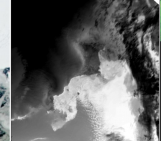
The GISP II (Greenland Ice Sheet Project Two) borehole at Summit Station, Greenland. Credit: N. B. Karlsson
Climate records from ice cores have helped scientists understand the past changes in climate.The GISP II (Greenland Ice Sheet Project Two) ice core was more than 3km long and was drilled during a five year period in the 1990s. After the drilling ended the casing of the borehole was extended above the surface, so that the borehole can still be accessed for remeasurements of, for example, temperature and changes in shape.





Anders Hedberg
Hello Nanna!
I wonder how far back can you go in the climate record of the ice core?
And perhaps more important, how long do you estimate it will take before Greenland’s entire ice sheet is all gone?
Nanna B. Karlsson
Hi Anders,
The deepest ice cores in Greenland go back to the last interglacial, i.e. more than 100,000 years ago. In Antarctica the ice is even older; at Dome C the ice core dates back 800,000 years. Scientists are now searching for the best site to retrieve ice that is more than 1 million years old.
As for your second question, that really depends on the changes in climate in the future! There are a lot of processes that are still not well understood and I wouldn’t want to hazard a guess.
Thanks for your questions!
Best,
Nanna